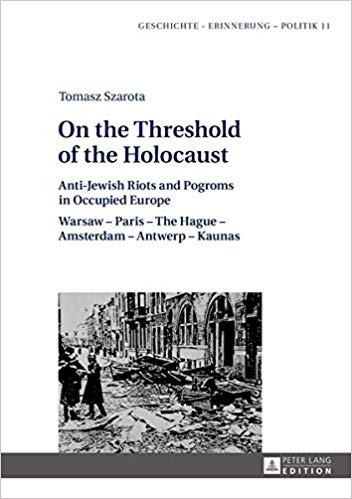German Guilt Diffusion Overt Example “We’re All Eichmanns” Szarota

On the Threshold of the Holocaust, by Tomasz Szarota. 2015
Over-Attention, to Comparatively Trivial Events, Unwittingly or Wittingly Reduces German Holocaust Guilt
This book dwells on civil disturbances, including those in which Jews were targets, in such places as Warsaw, The Hague, Amsterdam, Paris, and Kaunas. This alone is problematic. It soon becomes obvious that the events in Poland were minor compared with those in some other countries—yet they are all lumped together.
In addition to all this, no context is provided. The reader is not even told that riots are common and unremarkable events in times of the breakdown of civil authority, such as occurs during wars.
I focus on the events of 1939-1940 in German-occupied Poland.
Regardless of the actual intentions of the author, this book reinforces the standard Jews-are-victims standard narrative, now extending it even to comparatively-trivial civil disturbances. The fact of a few Jews beaten up Poles, for example, now becomes mixed-up, in the public mind, with the later Nazi-German murder of 6 million Jews. The mystification of the Holocaust is what allows this to happen.
WHODONIT? UNPROVEN INDEPENDENCE OF RIOTOUS ACTIONS FROM GERMAN INSTIGATION
Author Tomasz Szarota candidly acknowledges that, “It has proven impossible to determine the connections and contacts of local fascist and anti-Semitic formations with the persons acting on behalf of occupational authorities (of whatever sort) in Warsaw, between autumn 1939 and spring 1940; in Paris, in the summer of 1940; in The Hague and Amsterdam, in February 1941; and in Antwerp, in April 1941. Either the relevant documents have been destroyed, or the connections and contacts have left no trace in writing.” (p. 13).
RELATIVIZING NAZI GERMAN CONDUCT
Legitimate questions about the dilution of German guilt can be contemplated by imagining a scene, from the theater of the absurd, wherein the traffic-light-violator is conflated with the mass murderer. After all, they are both lawbreakers. Although, to be sure, the distinction between the mass murderer and the traffic-light-violator is never formally denied, it does not have to be. Simply the constant over-attention and opprobrium, to the traffic-light-violator, are sufficient to reduce, in the public mind, the guilt of the mass murderer. So also occurs when the anti-Jewish rioter is conflated with the German genocidal Jewish killer.
The perceptive reader’s suspicions can be heightened by the fact that this study was supported by a number of western European research facilities, including the ZENTRUM FUR ANTISEMITISMUSFORSCHUNG in Berlin. (p. 16). Moreover, the publisher of this book is a German one—Peter Lang GmbH at Frankfurt am Main. The informed reader knows that Peter Lang GmbH has published many anti-Polish books.
ORWELLIAN REDUCING OF THE GUILT OF THE GERMANS—THE SMOKING GUN
Any doubt about what this book is all about is settled author Tomasz Szarota, who writes, “The anti-Jewish incidents and, to a much greater degree, the pogroms carried out in the East of Europe show the capacity of human nature—what man is capable of doing to his fellow man…The Germans were not, after all, the only participants in the beatings and killings of Europe’s Jews—which should serve as additional proof that there are no ‘criminal’ nations, or nations that are incapable of committing such crimes.” (p. 15). So, according to Szarota, are we all Eichmanns?
In other words, the Nazi German genocidal mass murderer is not so bad after all. This is because, assuredly, what they did is just part of “human nature”, and, moreover, “we are all capable of doing such things.”
The diffusion of responsibility away from the Germans has other implications. If “all of Europe is guilty”, it means that “all Europeans owe the Jews something”. Enter the Holocaust Industry.
CONFLATING UNIMPORTANT AND IMPORTANT EVENTS
Imagine the journalist who pays as much attention to the firetruck that is “disturbing the neighborhood peace with its siren” as to the fire that is destroying buildings and taking human lives. This farcical situation is what is exhibited books of this type. It focuses on a small number of Jews bruised in riots, and so, by its very nature, diverts attention from much more important events of the same time, such as the hundreds of thousands of Poles already murdered by the Germans.
What’s more, Szarota’s research (pp. 36-39) greatly exaggerates movements that had insignificant following among Poles. Other than those who read this book, whoever even heard of GOSPODARCZA ORGANIZUJMY JEDNOSC and its symbol, the TOPORZEL, or of fringe-element neo-pagan-Slavic thinking among a few Poles?
To see a series of truncated reviews in a Category click on that Category:
- All reviews
- Anti-Christian Tendencies
- Anti-Polish Trends
- Censorship on Poles and Jews
- Communization of Poland
- Cultural Marxism
- German Guilt Dilution
- Holocaust Industry
- Interwar Polish-Jewish Relations
- Jewish Collaboration
- Jewish Economic Dominance
- Jews Antagonize Poland
- Jews Not Faultless
- Jews' Holocaust Dominates
- Jews' Holocaust Non-Special
- Nazi Crimes and Communist Crimes Were Equal
- Opinion-Forming Anti-Polonism
- Pogrom Mongering
- Poland in World War II
- Polish Jew-Rescue Ingratitude
- Polish Nationalism
- Polish Non-Complicity
- Polish-Ukrainian Relations
- Polokaust
- Premodern Poland
- Recent Polish-Jewish Relations
- The Decadent West
- The Jew as Other
- Understanding Nazi Germany
- Why Jews a "Problem"
- Zydokomuna